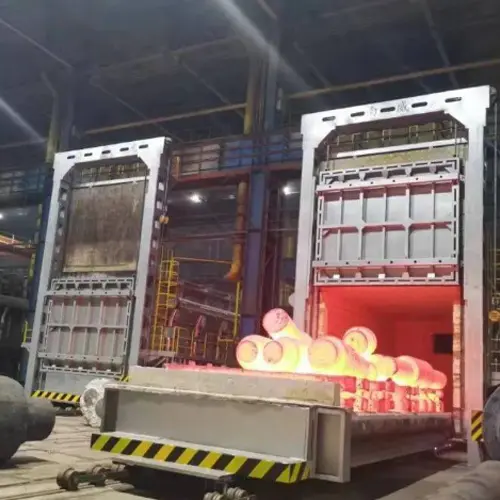Casting heat treatment process refers to a process method that changes the internal structure of the casting by means of heating, insulation and cooling to achieve the purpose of improving material properties, eliminating internal stress, and improving performance. Casting annealing process is widely used in various casting fields, especially for large, complex or high-performance castings, annealing treatment is an indispensable part, which is of great significance to improving product quality and service life.
1. Definition
Casting annealing is a heat treatment process that heats the casting to 20~30℃ above the critical point (usually Ac3, that is, the austenite transformation start temperature of steel), keeps it warm for a certain period of time, and then cools it at a very slow cooling rate.
2. Purpose
2.1 Optimize the structure: Annealing can refine the grains and improve the performance and mechanical strength of the casting.
2.2 Eliminate residual stress: Residual stress will be generated during the casting process, and annealing can eliminate these stresses to prevent deformation or cracking of the casting.
2.3 Improve processing performance: The hardness of the annealed casting is moderate, which is convenient for subsequent mechanical processing and improves processing efficiency and quality.
3. Annealing process classification
According to the different heating temperature, holding time and cooling method, the annealing process can be divided into many types.
3.1 Stress relief annealing
Purpose: To eliminate the internal stress generated in the casting during the casting process.
Process: Heat the casting to 500-550℃, keep it for a certain period of time, cool it in the furnace to a certain temperature, and then air cool it out of the furnace.
Effect: 90~95% of the internal stress of the casting can be eliminated, but the cast iron structure does not change. If the temperature exceeds 550℃ or the holding time is too long, it will cause graphitization, which will reduce the strength and hardness of the casting.
3.2 High-temperature graphitization annealing to eliminate the white cast of the casting
Purpose: To eliminate the white cast structure generated when the casting is cooled. The structure is hard and brittle, has poor processing performance, and is easy to peel off.
Heating: Heat the casting to the complete austenitization zone, generally between 900-950℃, control the heating rate at 70-100℃/H, and slowly heat it to 850-950℃. During this process, the cementite in the casting begins to decompose and form austenite and graphite.
Insulation: After heating to the specified temperature, the casting needs to be kept at this temperature for a period of time, generally 2-hours. The length of the insulation time depends on the wall thickness, shape complexity and chemical composition of the casting. The purpose of insulation is to fully decompose the cementite while avoiding the growth of austenite grains and reducing performance.
Cooling: After the insulation is completed, the casting needs to be cooled in a certain way. The choice of cooling method depends on the matrix structure and performance required by the casting. A common cooling method is to directly air cool the casting after high-temperature graphitization to obtain a high-strength pearlite + graphite structure. Another way is to obtain the annealed structure of ferrite + graphite, keep it at 680-720℃ for 1-4 hours, perform low-temperature graphitization, decompose the cementite in the pearlite into ferrite + graphite, and then cool it to 600-500℃ and air cool it out of the furnace.
3.3 Spheroidizing annealing
Spheroidizing annealing is mainly used for ductile iron castings. The purpose is to decompose cementite into graphite, obtain a mixed structure of ferrite and graphite, and change the matrix structure of ductile iron through a specific heating and cooling process, thereby improving its strength, plasticity and toughness. This process includes low-temperature annealing and high-temperature annealing.
Low-temperature annealing
Heating temperature: heat the casting to 720-760℃.
Holding time: keep warm for 3-6 hours.
Cooling method: slowly cool to 600℃ with the furnace and then air cool out of the furnace.
Effect: graphitize and decompose cementite in pearlite, thereby obtaining high-toughness ferrite ductile iron.
High-temperature annealing
Heating temperature: heat the casting to 900-950℃.
Holding time: keep warm for 1-4 hours for the first stage of graphitization.
Cooling and re-holding: cool the furnace to 720-780℃, keep warm for 2-8 hours, and carry out the second stage of graphitization. If the furnace is cooled to 600℃ and then air-cooled, only the first stage of graphitization is completed to obtain pearlite ductile iron.
Effect: Eliminate white cast iron and obtain high-toughness ferrite ductile iron. Through complete second-stage graphitization, ductile iron with ferrite as the matrix can be obtained.
4. Precautions
4.1 Temperature control: The heating and insulation temperatures must be strictly controlled to ensure that the internal structure of the casting achieves the expected transformation.
4.2 Cooling rate: The cooling rate must be slow and uniform to avoid new stress or structural defects inside the casting.
4.3 Equipment selection: Select appropriate heating equipment, such as resistance furnace, induction heating furnace, etc., according to the size, shape and annealing process requirements of the casting.
In summary, the casting annealing heat treatment process is one of the important means to improve the quality and performance of castings. Through reasonable annealing treatment, the residual stress in the casting can be eliminated, the organizational structure can be optimized, and the processing performance can be improved, thereby improving the service life and reliability of the casting.





